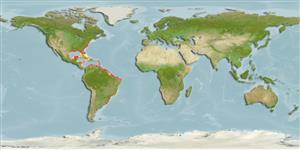Common names from other countries
Classification / Names / Names
Namen | Synonyme | Catalog of Fishes (gen., sp.) | ITIS | CoL | WoRMS
Environment: milieu / climate zone / depth range / distribution range
Ökologie
; tiefenbereich 0 - 68 m (Ref. 104365). Tropical, preferred 25°C (Ref. 107945); 43°N - 35°S, 98°W - 33°W (Ref. 3446)
Western Atlantic: from Cape Cod, Massachusetts, to the West Indies and Brazil.
Length at first maturity / Size / Gewicht / Alter
Maturity: Lm ? range ? - ? cm Max length : 7.6 cm SHL Männchen/unbestimmt; (Ref. 78146)
Equivalved, oval in shape. Size range: 2.8-7.6 cm shell length. Shell length to height ratio = 1.16 (Ref. 78148). Shell depth reaching 70% of height (Ref. 78152).
In the USA, this species remains a potential fishery resource. From the late 1990s to early 2000s, wild stocks of this species are the target of a small-scale fishery in North Carolina (Ref. 78154) and the eastern coast of Virginia with exports primarily as ethnic food to Chicago, New York, Los Angeles and Washington D.C. (Ref. 78152).
Sexes are separate with low incidence of hermaphrodism (2.17%). Males dominant (m/f=2.68). Peak in gonadal pattern in late spring to early summer (45% ripe in May) and a minor peak in winter (21% ripe in December). Dribble spawning likely strategy to extend spawning period and increase reproductive success.
Turgeon, D.D., J.F. Quinn Jr., A.E. Bogan, E.V. Coan, F.G. Hochberg, W.G. Lyons, P.M. Mikkelsen, R.J. Neves, C.F.E. Roper, G. Rosenberg, B. Roth, A. Scheltema, F.G. Thompson, M. Vecchione and J.D. Willams. 1998. (Ref. 1667)
IUCN Rote Liste Status (Ref. 130435: Version 2024-1)
CITES Status (Ref. 108899)
Not Evaluated
Not Evaluated
Bedrohung für Menschen
Harmless
Nutzung durch Menschen
Fischereien: weniger kommerziell; Aquakultur: experimental
FAO - Fischereien: landings | FishSource | Sea Around Us
Tools
Internet Quellen
Estimates based on models
Preferred temperature
(Ref.
115969): 14.5 - 28, mean 25.4 (based on 490 cells).
Widerstandsfähigkeit
hoch, Verdopplung der Population dauert weniger als 15 Monate. (K=0.45; tm=5).
Verwundbarkeit
Moderate vulnerability (37 of 100).
